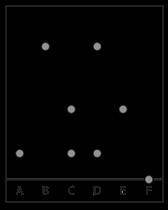
Chemistry, 19.11.2020 17:20 edgarnino13
Easy question on chromatography
Drawing B shows what the finished chromatogram looked like. Sam has drawn lines on it to help her to see which blobs are level with each other.
2 Three of the inks have only one colour in them.
a Which three are they?
b Explain your answer.
3 a Which inks are mixed to make ink C?
b Which inks are mixed to make ink D?


Answers: 1


Other questions on the subject: Chemistry

Chemistry, 22.06.2019 08:00, PrincessKeliah5538
Me i dont know what to do! the table compares the number of electrons in two unknown neutral atoms. comparison of electrons atom number of electrons a 10 d 11 use this information to determine the number of valence electrons in the atoms. which of the following correctly compares the stability of the two atoms? both are unreactive. both are highly reactive. a is unreactive and d is reactive. a is reactive and d is unreactive.
Answers: 1


Chemistry, 22.06.2019 16:50, TrueKing184
Answer asap need by wednesday morning explain how a buffer works, using an ethanoic acid/sodium ethanoate system including how the system resists changes in ph upon addition of a small amount of base and upon addition of a small amount of acid respectively. include the following calculations in your i. calculate the ph of a solution made by mixing 25cm3 0.1m ch3cooh and 40cm3 0.1m ch3coo-na+. [ka = 1.74 x 10-5 m] ii. calculate the ph following the addition of a 10cm3 portion of 0.08 m naoh to 500cm3 of this buffer solution. iii. calculate the ph following the addition of a 10cm3 portion of 0.08 m hcl to 200cm3 of the original buffer solution.
Answers: 1
You know the right answer?
Easy question on chromatography
Drawing B shows what the finished chromatogram looked like. Sam has...
Questions in other subjects:

History, 21.01.2022 04:30

Mathematics, 21.01.2022 04:30


Mathematics, 21.01.2022 04:30

English, 21.01.2022 04:30

History, 21.01.2022 04:40

History, 21.01.2022 04:40

Physics, 21.01.2022 04:40


History, 21.01.2022 04:40



